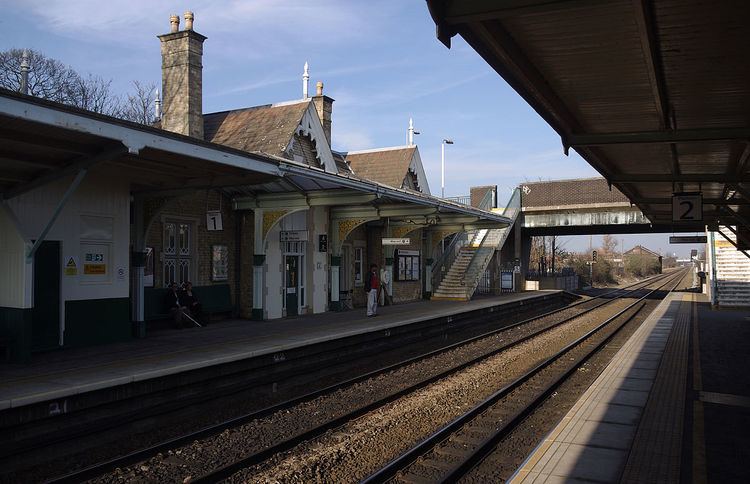Station code BEE DfT category D Opened 1839 | Grid reference SK533362 2011/12 0.540 million Number of platforms 2 | |
 | ||
Similar Attenborough railway station, Bingham railway station, Radcliffe railway station, Netherfield railway station, Long Eaton railway station | ||
Beeston railway station design no traffic lights simulation
Beeston railway station is a Grade II listed railway station on the Midland Main Line which serves the town of Beeston in Nottinghamshire, England. It lies 3.2 miles (5.1 km) south-west of Nottingham railway station, and 750 metres (0.5 mi) south-east of Beeston transport interchange for local buses and Nottingham Express Transit trams. The station is managed by East Midlands Trains.
Contents
- Beeston railway station design no traffic lights simulation
- Beeston railway station design 2 traffic lights simulation
- Description
- Services
- Facilities
- History
- Post WWII
- Nottingham remodelling scheme
- 1881 census
- Miscellaneous
- Station Masters House
- Other information
- References
Beeston railway station design 2 traffic lights simulation
Description
Beeston station is on the Midland Main Line, 123 miles 22 chains (198.4 km) from London, on the spur towards Nottingham. There are two platforms: platform 1 to the north for trains towards Nottingham and Lincoln and platform 2 to the south for trains towards London, Leicester, Birmingham and Derby. The platforms may be accessed either by steps from the Station Road bridge or by short ramps from Station Road for Platform 1 or Technology Drive for Platform 2.
Services
Services at Beeston are provided by East Midlands Trains and CrossCountry, with the former providing most services and managing the station. There are usually 4 trains per hour from each direction. The East Midlands Trains stopping service between London and Nottingham (via Loughborough, Leicester, Market Harborough, Kettering, Wellingborough, Bedford and Luton Airport Parkway) calls in each direction, as do the Leicester-Lincoln Central via Newark Castle and the Newark Castle/Nottingham-Matlock via Derby services. The hourly CrossCountry Nottingham-Birmingham New Street via Derby service also stops here, along with a few through trains to/from Cardiff Central. There is also a single daily direct CrossCountry southbound only service to Bournemouth via Derby, Birmingham New Street and Reading.
Facilities
Passenger numbers using the station have risen substantially in recent years, facilities include: a ticket office and ticket vending machines, a café, bicycle racks, car parking and taxi rank.
The Derby-Nottingham section of Route 6 of the National Cycle Network passes by the station and provides a traffic free cycle route to the University of Nottingham.
Network Rail have a long term aspiration to extend both platforms by up to 69 metres.
East Midlands Trains have a long term aspiration to provide lifts at Beeston railway station.
History
The station was built in 1839 for the Midland Counties Railway. Services began on 4 June 1839. In 1844 the Midland Counties Railway joined with the North Midland Railway and the Birmingham and Derby Junction Railway to form the Midland Railway.
The first station from Nottingham, at the time it was very popular with people from the city who wished to spend a day in the countryside, desiring "fresh air and recreation".
The original station building, which was little more than a cottage, was replaced in 1847 with the substantially larger white brick building with ashlar trimmings which still exists. This is notable for its carved bargeboards, some remaining diagonal paned windows and the pseudo-heraldic shields with 'MR' and '1847'. The wooden platform canopies and adjacent wrought-iron and glass canopy were installed in 1871. The wooden platform canopies were originally located at Southwell railway station, and were relocated to Beeston when Southwell was rebuilt.
The growth of Beeston led to substantial expansion of the station facilities in the Edwardian period. An extension containing a large booking hall, ladies' waiting room and parcels office was added to the rear of the station building, doubling its floorspace.
In 1937 the Midland Railway drew up plans for an additional waiting room on platform 2 but the plan was never put into action.
Post-WWII
The level crossing, lattice footbridge and signal box survived until 1969 when Beeston and Stapleford Urban District Council built a road bridge ("Station Bridge") across the railway to ease traffic delays caused by the frequent closure of the level crossing. This effectively replaced the footbridge between the two platforms.
With the decline in passenger numbers in the 1980s, the entire station suffered from vandalism and neglect, and British Rail proposed complete demolition. A spirited campaign by the local civic society and rail historians led to the listing of the station building in 1987. A separate listing application was made in the early 1990s and the platform shelters were also listed. This was followed by restoration of what remained of the 1847 building and the platform shelters. The (architecturally undistinguished) extension was demolished, revealing the original gables on the north side of the building.
The original platform masonry survived until 2004 when the platforms were completely rebuilt.
Nottingham remodelling scheme
Between 20 July and 25 August 2013, the services from the station were reduced because of the Nottingham remodelling and resignalling scheme. It acted as a terminus for trains from London via East Midlands Parkway and from Derby, with a frequent rail-replacement shuttle bus running to and from Nottingham while the western end of the station and approach lines were remodelled.
1881 census
The railway employed a large number of local people. The 1881 census for Beeston shows 141 men with railway employment although there is no evidence that they all worked in Beeston.
Miscellaneous
In 1864, John Ashe is listed as the booking clerk.
Leslie Blood worked in the booking office from 1926 to 1939 when he was promoted to the position of Stationmaster at Stoke Golding.
Sir Neil Cossons, now Chairman of English Heritage, worked as a junior porter in his youth.
